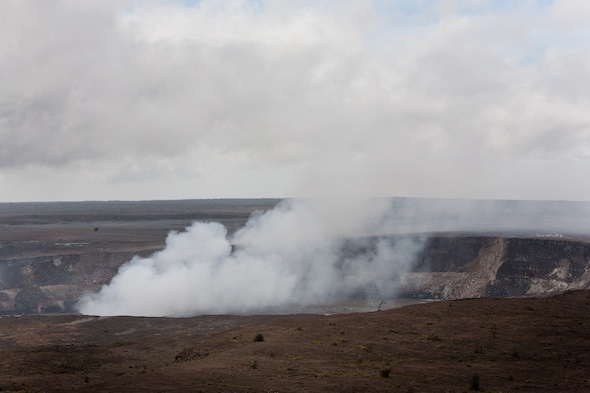A VIOLENT VOLCANO MAKES FOR ONE OF HAWAII’S HOTTEST SIGHTS

You’ve probably created a model of one in elementary school. Volcanoes are the stuff of science and spectacular sojourns.
For those who travel to Hawaii — a visit to one of the few active volcanoes in the world today is a once in a lifetime experience, and stunning sight to behold. The baby of Hawaii’s volcano ohana (family) is Kilauea, among – if not the — most active volcanoes not just on Hawaii Island but the world over.
Hawaiians named the summit of the volcano Kilauea, but over time scientists and visitors have extended the name to include the entire volcano. Some often mistake Kilauea to be part of Mauna Loa – a larger volcano – but both are separate and distinct with their own vents and conduits.
Today Kilauea rises more than 4,190 feet above sea level and makes up close to 15 percent of land area on Hawaii Island. Flanking the southeastern coast of Hawaii Island, the name Kilauea in Hawaiian translates to “spewing” or “much spreading.”
On average, Kilauea pumps out more than 250,000 to 650,000 cubic yards of lava – each day. Roughly, this is enough to resurface a two-lane road for 20 miles. And since 1994, Kilauea has expanded Hawaii Island by 491 acres.
Scientists estimate that Kilauea first erupted more than 300,000 to 600,000 years ago. While Kilauea’s eruptions are prominently mentioned throughout Hawaiian history and legends, a written history for the volcano dates back only to the 1820s when missionaries arrived and took note.
Since 1952 alone Kilauea has erupted 34 times. And ever since January 3, 1983, Kilauea has erupted continuously along its east rift zone.

Hawaii’s fire goddess’ hale
Lighting up ancient legend, Pele (pronounced peh-leh) the goddess of fire, lightning, wind, dance and volcanoes is a well-known Hawaiian deity. Otherwise known as ka wahine `ai honua, the woman who devours the land, Pele’s home is believed to be Halema`uma`u crater, at the summit of Kilauea. She is renowned for her passionate and fiery temperament and many people who visit the islands hear stories of her power and destruction. For more on Pele read our blog post here.
Home to a host of volcanoes
Editor’s Note: Most of Hawai‘i Volcanoes National Park is currently closed due to hazardous and increased earthquakes, corrosive ashfall, and an expected explosion at the summit of Kīlauea Volcano. The park will reopen closed areas only when it is safe to do so. Visit www.nps.gov/havo/index.htm for the latest information on park availability.
A sacred place for Native Hawaiian, located 30 miles southwest of Hilo is the Hawaii Volcanoes National Park, home to Kilauea and her sister craters. Founded in 1916 when President Woodrow Wilson signed a bill forming the park, the Hawaii Volcanoes National Park tops the list of state visitor attractions, hosting on average 2.6 million guests each year.
Covering more than 330,000 acres from the summit of Mauna Kea down to the Pacific Ocean, the Hawaii Volcano National Park offers 150 miles of hiking trails which take visitors on a journey through volcanic craters and rainforests, and past petroglyphs, a lava tube, and active volcanoes.
The Kilauea Visitor Center is open daily from 7:45 a.m. to 5 p.m. The center offers an hourly film, which runs from 9 a.m. to 4 p.m., providing first-time guests an introduction to the park. Park rangers are also on hand to give talks, lead guided activities and provide information on the park’s hikes and the latest eruption updates.
When visiting, we typically aside a full day to fully experience Kilauea and the Hawaii Volcanoes National Park. We recommend staying in Hilo (roughly a 45 minute drive) and bringing adequate food and water since the park does not have any facilities. When packing for the trip, include comfortable walking shoes, long pants, a jacket, binoculars – and of course, a camera!
At the park, be sure to stay on marked routes and follow all signs and instructions. Before you head out you can check for the latest eruption updates at http://hvo.wr.usgs.gov/ or by calling (808) 967-7328.
Want to experience Hawaii Island for yourself? Check out some of our tours here.
